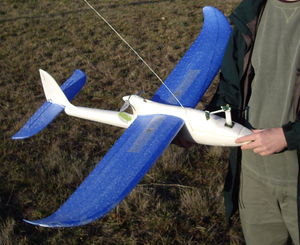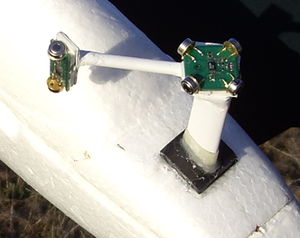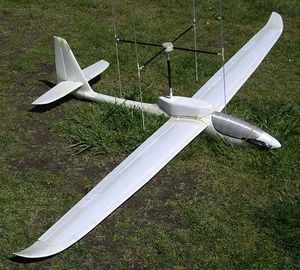User:John Burt
About me
I am a University of Washington Research Scientist who studies bioacoustics and animal behavior. I also design and build hardware and develop software for use in various scientific research projects. Besides science, my other passion is RC model aircraft, particularly gliders and electrics. My Paparazzi project is an attempt to combine my work with my hobby.
I currently live in Portland.
Current Project: COTS UAV System for Biological Research
Field biologists, conservationists, and wildlife management agencies have many potential applications for small UAV systems. However, UAVs aren't frequently used in these areas because 1) they are perceived to be too expensive, difficult, or complex, and/or 2) people are simply not aware of the potential uses of UAVs in their field.
The goal of this project is to develop and promote a UAV platform for biological research, conservation work, and wildlife management. The UAV system I am building is intended to be extremely rugged, cheap, relatively easy to use and maintain, flexible, and hackable for different missions. The system is ultimately intended to be used in extremely difficult and remote field environments where there is no internet or reliable power source (e.g., African bush, South America, South Pacific, US Pacific Northwest wilderness).
Airframes
I am currently exploring two Multiplex products:
Easystar:
Advantages:
- Extremely stable flight characteristics, yet reasonably efficient.
- Rugged elapor foam, which I reinforce with strapping tape to increase rigidity.
- Pylon pusher configuration reduces motor/prop damage from hard landings.
- Lots of room in fuselage, and foam allows easy modification.
- Cheap, easy to assemble kit.
- All parts are replaceable with little or no assembly.
- If assembled properly, can be broken down to small size for transport.
- Minor changes to stock construction allowing further breakdown for transport.
Modifications:
- Brushless motor with folding propellor.
- Hacked canopy, allowing avionics to be stowed in canopy.
- Modification mid fuselage to mount high rez digital camera for aerial imaging.
- Strapping tape reinforcement on fuse and wings to ruggedize the airframe.
- Aileron mod for Paparazzi autopilot testing.
- Minor changes to stock construction allowing further breakdown for transport.
Progress:
- Airframe tested and flying.
- Flight tests w/ AP in Auto1 mode. AP successfully performed basic attitude control.
- Flight tests w/ 9Xtend modem link to ground station. Successful real-time telemetry link.
- Brief flight test w/ AP in AUTO2 mode, then crash. Seems a voltage dip occurred when the motor turned on w/ low battery level, causing AP to enter brownout condition and lock up.
- Repairing airframe and waiting for weather to improve for further flight tests. Will use a separate battery to power AP to avoid motor-induced interference or power dips.
Cularis:
Advantages:
- Very efficient flight, good penetration.
- Rugged elapor foam, which I reinforce with strapping tape to increase rigidity.
- Lots of room in fuselage, and foam allows easy modification.
- Cheap, easy to assemble kit (more expensive and difficult to assemble than Easystar).
- All parts are replaceable with little or no assembly.
- Larger payload capacity and potential range than Easystar.
Modifications:
- Strapping tape reinforcement on fuse and wings to ruggedize the airframe.
- Hacked canopy, allowing avionics to be stowed in canopy.
Progress:
- Airframe tested and flying.
Flight logs
Flight on 2009/03/23:
Easystar flight test. At a small field in Vancouver. It was overcast and cold. Occasional rain / showers / hail. Wind sometimes calm, other times 5-10mph or so.
Flight 1: Launched in manual mode (mistake), auto1 mode gave good stability. auto2 mode also cut throttle, and plane seemed to wander around too far away.
Flight 2: started in auto1 mode. Figured out the correct sequence to allow auto2 mode to launch: click Takeoff, then Launch, then launch the plane in Auto1 mode. We also fixed default altitude, which was set too low (ground alt was 60m). In this flight, I was able to get ES to circle over home and auto-maintain altitude by varying throttle. However, flight behavior was affected by the wind: the plane would get downwind and then flounder with nose pitched up. Eventually, I switched to auto1 and dipped the nose down to penetrate into the wind and get the plane home.
Flight on 2009/03/30:
Easystar flight test. New flying site at big field near Vancouver Lake, WA.
Flight 1: launched in Auto1 mode. Climbed out and switched to Auto2 for route testing. The plane is still over-correcting when making course changes. Tends to "waffle" around and never does neat circles around wp,etc. Tested line 1-2 in basic config. Worked more or less, but waffling caused plane to wander around a lot.
Flight 2: launched in Auto2 mode. Plane dove into ground, hit and skidded, then rose into the air. Shallow climb at first (100% throttle), then began steep circles at high speed and low altitude. Eventually crashed. I had tried to switch to manual mode on RC TX, but AP did not respond (only after plane was on ground). Probable issues: CLIMB wp alt=25m was too low, climb pitch too low, CLIMB wp too close to launch point (should be at least 200-300m out I think).


